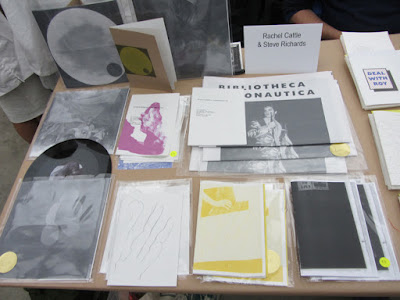12 Sep 2015
https://www.ica.org.uk/whats-on/artist-self-publishers-fair-asp
The inaugural Artist Self-Publishers' (ASP) Fair, featuring over 50 UK and international independent artist self-publishers who will come together for a one-day fair.
Ritual Mnemonics, a 12" vinyl record (with 4 cover variations), consisting of excerpts from the sound archive of The Library Of Aeronautics.
Side 1, track i: Hibiscus Flower / Coded Radio Transmission
Excerpts from Cocteau's Orphee(1950) and Le Testament d'Orphee(1960)
The presence of the hibiscus in Jean Cocteau's Le Testament d'Orphee(1960) is coincidental to both the sound of a triad of notes and the sudden emergence of a protagonist from what seems to be a kind of interdimensional portal or void. Taken as a musical reference to the flatted fifth interval/tritone substitution, the so-called 'diabolus in musica', represents the excluded and/or inharmonious aspect that is hidden or marginalised and which can only be witnessed during a Faustian-type pact. The tritone accompanying the hibiscus may also be considered as symbolising a rupture of prescribed codes and the possibility of multiple alternative tunings or improvisatonal modes via a dissonant chord or interval. (The triad of notes is recorded using a Cristal Baschet).
A radio transmission heard in Cocteau's Orphee(1950), thought to be modelled on transmissions generated by British and French Resistance agents during World War Two, exemplifies the witnessing of an event originating from outside of existing parameters, seemingly displaced but representing an inconsisternt mutliplicity that lies beneath the particular existing& order:Where could they be coming from? No other station broadcasts them. I feel certain they are addressed to me personally.
Side 1, track ii: Tritones: Descending / Ascending Octaves
Example, played on a recorder, of a tritone paradox, an auditory illusion in which a sequentialy played pair of Shepard tones separated by an interval of a tritone, or half octave, is heard as ascending by some people and as descending by others. (The tritone paradox was first proposed by Roger Shepard and demonstrated empirically by psychology of music researcher Diana Deutsch in 1986).
The auditory illusion of descending / ascending octaves references exercises performed in order to divide attention and so achieve the possibility of an increased observational perspective. Such exercises, advocated by P.D. Ouspensky (1878-1947), ultimately reference the ars memorativa of Giordano Bruno and the& Pythagorean tuning system in order to further develop mnemotechnics.
Side 2, track i: It Goes Something Like This
Live performance introductions and repetitions recorded between 1954-56 by Elvis Presley. The subject is thought to be under post-hypnotic suggestion and in a heightened emotional state. Sleeve notes& by The Library Of Aeronautics state that the repetition of the introductory phrase it goes something like this may be used to remind the listener of& their own subective state of multiplicity.
Side 2, track ii: I Forgot to Remember to Forget
Audio collage examining live performance from 1955 by Elvis Presley, where subject is discernibly under post-hypnotic suggestion and where crowd reaction is indicative of hypnotic transference. An implication of this sound piece is that audience/listener and performer are exhorted to remember multiplicity but remain trapped in repetitive performance of the social distinctions and alienation between the singular performer and audience.
Newspaper of The Library Of Aeronautics containing archive images and publication that considers the history of the tritone and its use.



